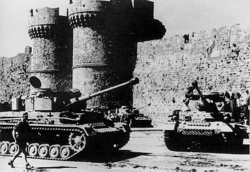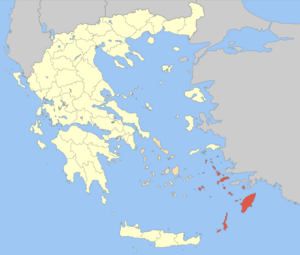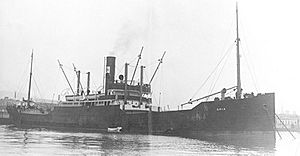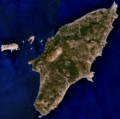Battle of Rhodes (1943) facts for kids
Quick facts for kids Battle of Rhodes (1943) |
|||||||||
|---|---|---|---|---|---|---|---|---|---|
| Part of the Dodecanese Campaign of the Second World War | |||||||||
 German Panzer IVs in Rhodes. |
|||||||||
|
|||||||||
| Belligerents | |||||||||
| Commanders and leaders | |||||||||
| Strength | |||||||||
| 39,100 men (34,000 Army, 3,000 Air Force, 2,100 Navy) | 6,000–8,000 men | ||||||||
| Casualties and losses | |||||||||
| 447 dead 300 wounded 30,000 POW |
1 merchant ship captured | ||||||||
The Battle of Rhodes was a fight between Italian and German forces. It happened on Rhodes, a Greek island in the Aegean Sea. This island was controlled by Italy at the time. The battle was part of the Dodecanese Campaign during World War II.
Italy was secretly talking with the Allies to stop fighting. Germany knew this and was ready to take over Italian-held areas. They had already sent soldiers, tanks, and planes to Rhodes. The British also tried to trick the Germans with Operation Mincemeat. This made the Germans even more worried about the Aegean Sea area.
Contents
The Battle for Rhodes
Why the Battle Started
On September 8, 1943, Italy announced it had signed an armistice (peace agreement) with the Allies. This meant Italy was no longer fighting with Germany. Admiral Inigo Campioni was the Italian governor of Rhodes and nearby islands. He had no clear orders from Rome.
The Italian commanders on Rhodes had to decide: keep fighting with Germany or turn against them? They chose to see the Germans as enemies. This decision led to the German invasion of the islands.
Italian Forces on Rhodes
Admiral Campioni's main office was in the Palace of the Grand Master of the Knights of Rhodes. The Italian Army on Rhodes had about 34,000 soldiers. They were part of the 50th Infantry Division "Regina". They had some older vehicles and artillery guns.
The Italian Navy had about 2,100 sailors on Rhodes. They controlled coastal batteries (big guns near the sea). They also had a few small ships like motor torpedo boats.
The Italian Air Force had about 3,000 people and 60-65 aircraft. Most of these were older fighter planes like FIAT CR.42s and FIAT G.50s. Many planes were not ready to fly, and there were not enough pilots.
German Forces on Rhodes
Germany had started sending soldiers to Rhodes in January 1943. They slowly increased their presence. By June 1943, German General Ulrich Kleemann was on Rhodes. He formed a special unit called the Sturm-Division Rhodos.
This German force had between 6,000 and 8,000 men. They had about 150 armoured fighting vehicles. These included Panzer IV tanks and self-propelled guns. They also had powerful 88 mm Flak anti-aircraft guns. The Germans had their own communication system, separate from the Italians.
Before the Fight
The armistice news on September 8 surprised the Italians on Rhodes. Admiral Campioni tried to talk with General Kleemann. Kleemann seemed calm at first, saying he would cooperate.
Campioni told his forces to be ready to fight if attacked by anyone other than the Allies. An Italian officer suggested a surprise attack on the Germans at the Maritsa air base. But Campioni ordered them not to act, trusting Kleemann's promises.
However, the Italian Navy commander, Daviso, gave different orders. He told ships to go to Leros and coastal batteries to be ready. He said any German attack should be met with force.
Later that night, Kleemann became angry. He asked to move his troops freely to fight a possible British landing. Campioni refused this request.
The Battle Begins
September 9
Campioni and Kleemann argued about where German troops should be. A British plane dropped leaflets telling Italians to take over German positions. Campioni did not follow these orders.
Around noon, the first German attacks began. The Italians fought back. The Germans quickly captured General Scaroina, who then ordered his men to surrender. The Germans also took over the Maritsa air base.
Daviso wanted to send a destroyer to bomb the air base. But Campioni allowed artillery to fire instead. The Italian guns destroyed German tanks at the airport. They also accidentally hit some Italian planes still there.
The Italian coastal battery "Bianco" caused damage to German vehicles. But it was also badly hit and had to be left. Another battery, "Dandolo," was surrounded and its soldiers were captured.
September 10
During the night, two British officers parachuted onto Rhodes. They met with Campioni. They said it would take at least a week for British help to arrive. Campioni asked for air raids and landings to distract the Germans. But the British said they did not have the resources.
Early on September 10, German forces moved towards Maritsa. Italian artillery slowed them down. A German plane dropped leaflets asking Italians to surrender. An Italian destroyer arrived with 200 extra soldiers from Kos, but it was sent back.
Italian batteries continued to fight German guns. In the evening, German troops captured more Italian positions. Campioni learned that Italian forces in Greece and Crete had surrendered. This made his situation even weaker.
September 11
German air attacks damaged an Italian battery and a radio station. Another British officer arrived. He asked Campioni how long the Italians could resist. Campioni again asked for help against German planes.
An Italian officer, escorted by a German, brought a message from General Scaroina. Scaroina asked for the fighting to stop in the southern part of the island. Campioni replied that the battle would continue.
Later, two German officers told the Italians that Germany demanded an unconditional surrender. They said Rhodes city would be bombed if Campioni did not decide in half an hour.
Campioni discussed the situation with his staff. No British help was coming soon. Only a few Italian artillery batteries were still fighting. A German bombing would cause many civilian deaths. They decided to surrender.
Campioni, Forgiero, and Daviso met with Kleemann. Campioni would remain governor, but Italian units would be disarmed. German forces would stay outside the city. The Italians destroyed secret documents.
Italian soldiers were very angry and surprised by the surrender. Many believed they were winning. Some thought the news was about a German surrender. Many soldiers cried and broke their rifles.
Aftermath
After the surrender, the Germans had a problem with so many Italian prisoners. They disarmed the navy and air force first. General Kleemann ordered Campioni to tell the Italian forces on Karpathos to surrender. Campioni refused to give the same orders to Kos and Leros.
Many Italians tried to escape by sea. Some died at sea, others were caught. Some managed to reach Kos and Leros. The Italian garrison on Alimia island refused to surrender. They moved to Leros with their weapons.
On September 19, 1943, many Italian prisoners were put on a captured Italian ship, the Donizetti. A British ship, unaware of the prisoners, sank it. No one survived. On February 12, 1944, another old steamer, the Oria, sank in a storm. It was carrying over 4,000 prisoners from Rhodes. Only 21 prisoners were saved.
Some Italian soldiers got civilian clothes to avoid capture. A small number joined the German side. About 1,580 Italian soldiers escaped from Rhodes after the surrender. Many others died from ship sinkings or starvation in German prison camps. Ninety Italians were executed after the surrender.
Admiral Campioni was sent to a prisoner-of-war camp. He was later handed over to Italian authorities who supported Germany. He was tried and executed for defending Rhodes against the German invasion. Some Greek civilians and Italians who escaped continued to resist the German occupation.
Images for kids











